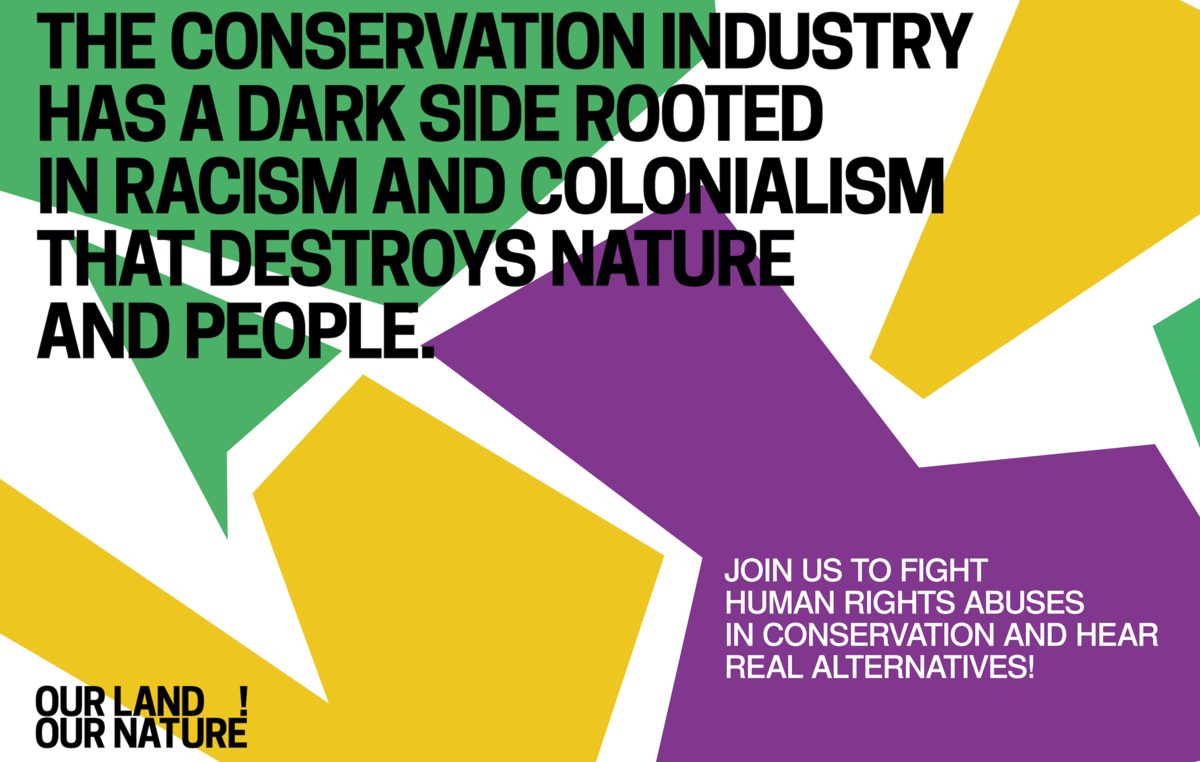
by DGR News Service | Oct 30, 2021 | Colonialism & Conquest, Culture of Resistance, Indigenous Autonomy, Repression at Home, The Problem: Civilization
This story first appeared in Survival.
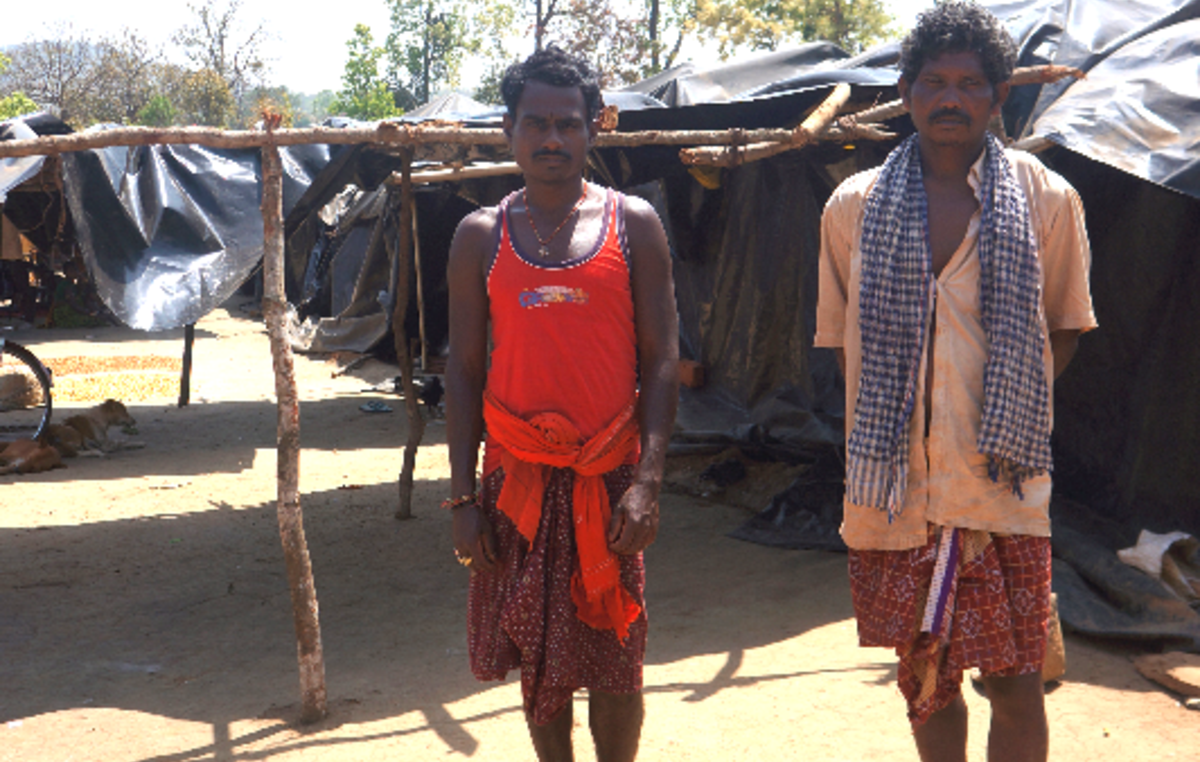
These Khadia men were thrown off their land after it was turned into a tiger reserve. They lived for months under plastic sheets. Millions more face this fate if the 30% plan goes ahead.
© Survival International
Participants in the world’s first Congress to decolonize conservation have released a manifesto calling for a total halt to new Protected Areas which exclude Indigenous and local communities.
The “Marseille Manifesto: a people’s manifesto for the future of conservation” has been released today by many Indigenous and non-Indigenous activists and experts who gathered for last month’s ground-breaking “Our Land Our Nature” congress.
They also demand:
– that governments “fully respect, protect and uphold Indigenous peoples’ land and forest rights, respect collective customary land and forest use by local communities, to ensure protection of that land in accordance with their wishes” as the primary means of protecting the world’s biodiversity
– “Governments and conservation organisations must acknowledge the huge toll that strictly protected conservation areas have taken on the lands, livelihoods and rights of many communities worldwide; they must make concrete plans for reparations of past wrongs, including through transferring control back to the historical and local guardians”
– “High income countries… must cease funding conservation programmes which destroy local people and livelihoods, including by failures of FPIC, irrespective of whether this is intentional or not.”
The manifesto calls for “a conservation model that fights against the real causes of environmental destruction and is prepared to tackle those most responsible: overconsumption and exploitation of resources led by the Global North and its corporations.”
The demand for a radical change to the current model of conservation has grown louder in recent months. The UN’s Special Rapporteur on Human Rights and the Environment released a strongly-worded policy brief in August, arguing that achieving environmental goals “demands a dramatic departure from ‘conservation as usual’.” His brief calls instead for a radically different, rights-based approach.
Many organizations and institutions, however, claim to endorse these calls while simultaneously promoting aggressive “fortress conservation” projects. The European Commission, for example, talks in its Biodiversity Strategy of “strengthen[ing] the links between biodiversity protection and human rights … and the role of indigenous peoples and local communities” – but continues to fund conservation projects in Africa that exclude them.
Likewise, 150 NGOs recently published an open letter calling on world leaders to put human rights at the centre of environmental policy – but the group included WWF, whose “secret war” of funding “vicious paramilitary forces” has been the subject of multiple media exposés and human rights investigations.
Fiore Longo, head of Survival’s Decolonize Conservation campaign, said today: “Most governments and NGOs these days are good at producing nice-sounding rhetoric about respecting Indigenous rights. But the same people are promoting a massive drive to create new Protected Areas on Indigenous lands as part of the 30×30 plan that constitutes the biggest land grab in world history.
“We can see the same pretence in calls for Nature-Based Solutions to climate change. These are really just a new spin on what used to be called carbon offsets. They’ll allow Indigenous lands to be bought and sold, in order to permit the world’s most polluting companies to carry on polluting.
“Only the full recognition of Indigenous peoples’ land ownership rights will prevent them from continuing to be the sacrificial victims of fortress conservation and Nature-Based Solutions. It’s also a key step in addressing the biodiversity and climate change crises.”
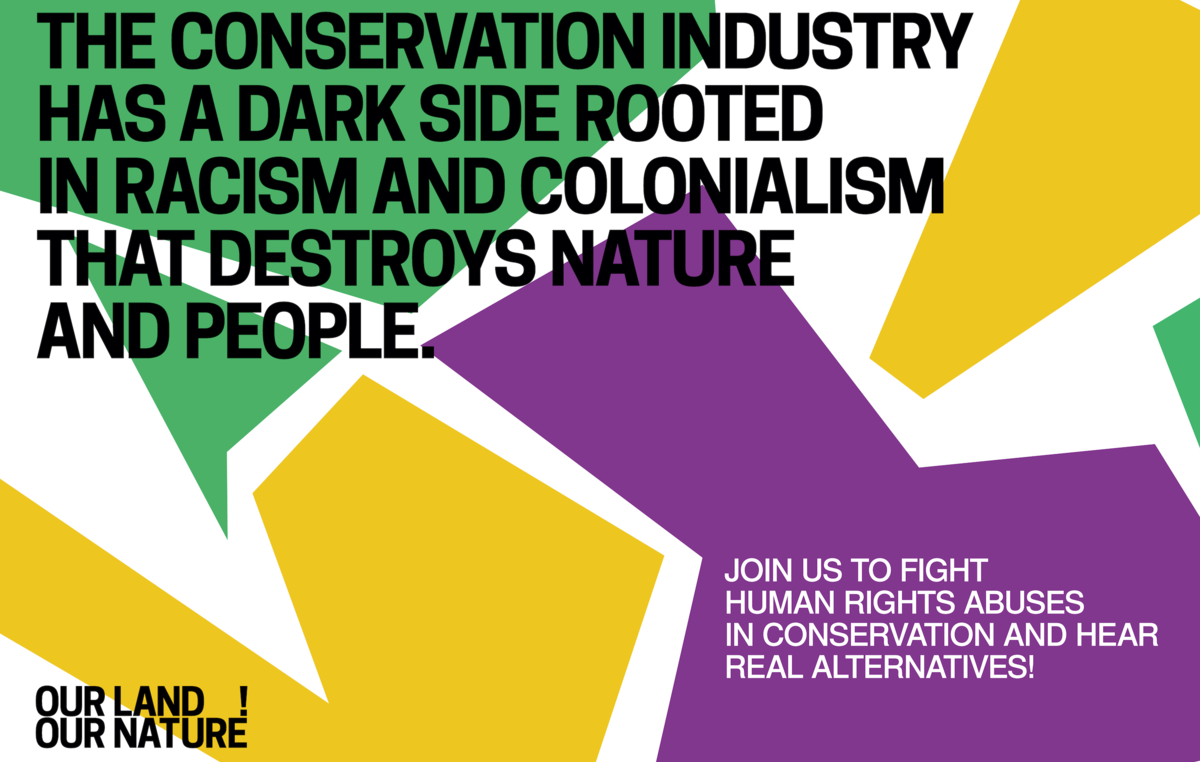
‘Our Land, Our Nature’. The conservation industry has a dark side rooted in racism and colonialism that destroys nature and people.
© Survival

by DGR News Service | Sep 20, 2021 | Repression at Home, Strategy & Analysis, Worker Exploitation
“A really efficient totalitarian state would be one in which the all-powerful executive of political bosses and their army of managers control a population of slaves who do not have to be coerced, because they love their servitude.” – Aldous Huxley
By Matej Kudláčik
Part two of this essay can be found here.
Many people stand with a torch and a sword defending against The Beast feasting on freedom – freedom in its truest sense. Against The Beast eating away kindness and love, putting great trenches between us. Enslaving us with constant entertainment, fleeting meaningless joys and pathetic pleasures. These are the revolutionaries, who can see through the veil or at least through some parts of it.
Socrates was hated and sentenced to death because of his revolutionary thinking. Galileo was imprisoned. The Middle Ages were a period when the Church established a brutal form of dictatorship – anyone disagreeing with the dictator, even with proof or undeniable truth, indicated that the dictator’s thought system has some flaws, which could not be tolerated. And in any age, anyone going against those who enslave or control the population is an enemy. Attacked even by those who are enslaved.
“No one is more hated than he who speaks the truth.” – Plato
And because of the hatred and violence that he will inevitably experience, a revolutionary should be defended at all costs. Just as a genius, a true revolutionary is as the rarest wonderful diamond hidden in a pile of rocks, thus should be protected and belongs to the whole world, destined to saving it. He who performs the art of a revolutionary should be guarded from forces crafted to steal our freedom away.
Not only are we in need of revolution in order to maintain freedom but we also find ourselves in the most dangerous form of totalitarianism. Dangerous mainly because we proudly call it democracy.
But what is freedom? No one explained this concept better than Immanuel Kant did, saying: “Freedom is independence of the compulsory will of another.”
Are we truly independent? If yes, why is mindless consumerism imposed on us exactly at a time when we’re most sensitive and influenceable, during our early childhood? Why are we being taught to depend on cheap entertainment, disarming us and erasing our ability to truly entertain ourselves with our own intellect? Why is it so rare to find a professor who teaches you how to think and helps you to strive towards critical thinking, rather than what to think? The freedom that every country is so foolishly proud of is truly apparent and false. We are dependent on senseless consumption. We are becoming tied to cheap dopamine we receive from technology, advertisement, plasticized food and drinks.
The importance of discussing and resisting against this dynamic is that without revolution, the capitalist totalitarianism and greed will most likely lead into dystopia and absence of the natural world. With constant pleasures and technology, just as Huxley predicted it in his Brave New World and later admitted that his prophecy is coming true much sooner than he initially thought.
And if mankind is lucky enough, perhaps this will lead to the extinction of our species, so that the coming generations will be spared of the unimaginable period of capitalist enslavement.
If we would travel from the past to the present without knowing anything about it, it’s very likely that we would not believe the terrible, isolating dystopia we see. Dystopia where soothing blindness is the norm. Where following the system means to be chained. And where being chained means to love one’s chains.
Everything about this suits the capitalists, because it distracts us. We are being led to hate by the mainstream media. We’re too busy fighting each other, rather than joining each other in solidarity and fighting against the real enemy. War on drugs is a great example of a capitalist tool because it’s clearly a complete failure that only supports drug use. Yet there’s nothing being done about it because it’s convenient for the capitalists: an addict won’t resist against the treacherous social, political, economical and environmental catastrophe.
We tend to blame ourselves, yet we should blame the ones who chained us. Freedom does not mean individual plenitude, freedom does not mean that you can travel around the world. We are being led to thinking this, and on top of that, we are being led to not see. To not see the women’s dreadful pain during rape and violence. Knowing that their rapists do not receive punishment is agonizing. We do not see the beautiful organizations of ecosystems, trees that hold bird nests with babies in safety being murdered to make space for human progress. Too many species will not see the light of tomorrow, for they went extinct today. We do not see the hospitals filled with dying mothers and children, who are not ready yet to disappear from this world.
Pleasure and convenience is available and far more accessible than in any time. It blinds us, we seek to feel better immediately, we seek comfort, creating an illusion of luxury and well-being of the world. We lose the ability to think with the help of our intellect. We lose the ability to love just with the help of our hearts. Yet we’re being told that it’s okay, so we’re smiling.
It is almost as if a person places a special fantoccini in front of a child, whilst others murder the parents and rob the house. The child remains enchanted, unaware of the screams of his parents. The plight is a well-constructed theatre, the director laughs with the screenwriter yet the actors do not know they’re in a play. That’s why their suffering is genuine. A revolutionary strives to see through the veil and dismantle the whole set, burn it down.
The enslaving dominant culture must fall.
Capitalist totalitarianism is the enemy, for it exploits our freedom.
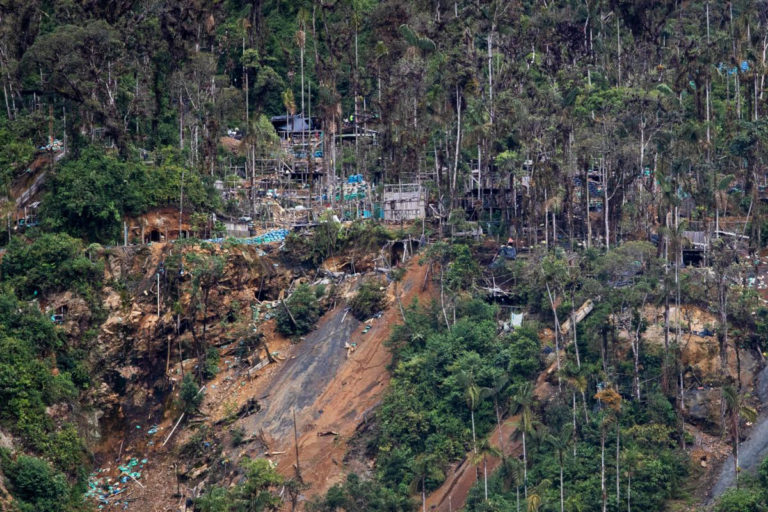
by DGR News Service | Sep 4, 2021 | Culture of Resistance, Mining & Drilling, Movement Building & Support, Repression at Home, Toxification
- The town of La Merced de Buenos Aires, in Ecuador, gained notoriety when it was invaded by illegal miners in 2017; for almost two years, the area was plagued by violence, prostitution and drug addiction.
- Authorities evicted the miners in 2019, but now the land may become home to legal mining operations, which many residents emphatically oppose.
- More than 300 people spent over a month blocking the path of the machinery, trucks and employees of Hanrine Ecuadorian Exploration and Mining S.A.
- The Ombudsman’s Office warns that confrontations will arise and has called on local, regional and national authorities to take immediate action.
This article originally appeared in Mongabay.
Featured image: This mountain in the parish of Buenos Aires was the epicenter of illegal mining between 2017 and 2019. Image by Iván Castaneira/Agencia Tegantai.
By Antonio José Paz Cardona | Translated by Sarah Engel
In 2017, the name “La Merced de Buenos Aires,” or simply “Buenos Aires,” became famous throughout Ecuador. This small parish located high in the Andean province of Imbabura was invaded by illegal miners who quickly took control of the mountains.
Giant mining camps made up of plastic tents garnered media attention, and the illegal nature of the mining brought violence, fear, and hopelessness to the area. The population that traditionally lived there cried out for help so that their territory would return to the tranquility that had characterized it in the past.
Several residents interviewed by Mongabay Latam say the gold rush attracted people from Peru, Venezuela, Colombia and southern Ecuador who intimidated the community. Former fighters from the now-dissolved FARC guerrilla group in Colombia even began to collect “vaccinations” — protection payments in exchange for not infringing upon them — and started to suppress the community in an attempt to dominate the illegal mining business.
In July 2019, 1,102 police officers, 1,200 soldiers and 20 prosecutors arrived in the area as part of an operation called “Radiant Dawn” (“Amanecer Radiante”). In the first few days of the raid, they managed to remove about 3,000 people from the mining camps. The operation also dismantled 30 gold-processing plants and a complex system of pulleys for transporting the gold. According to María Paula Romo, the minister of government at the time, the illegal gold trade in Buenos Aires was valued at about $500,000 per week.
For almost a year, an apparent sense of peace fell over the community. But in 2020, residents realized their land was being considered as a potential mining site again — this time in search of copper — by a company owned by an Australian firm. Since November 2017, the company has obtained eight mining titles in the area, one of which overlaps with the illegal mining area. The situation became increasingly tense in April, when more than 300 residents of Buenos Aires staged a protest on the outskirts of the parish in an attempt to stop the company’s trucks and machinery from starting mining activity in the territory.
Mining company sues dozens of people
The residents of Buenos Aires have declared their resistance. They say that since 2017, they have been invaded by illegal mining in this area, which has traditionally been dedicated to agriculture and cattle ranching. Now that legal miners want to exploit the land, many residents say they do not want any further involvement with mining.
The problem, according to a resident who asked not to be named for fear of retaliation, is that the resistance movement has generated a stigma. “They told us that we are illegal miners and that we do not want legality because we want to return to what is illegal. But this is false,” the resident said.
Natalia Bonilla, from the organization Acción Ecológica, says that when her organization began to work with the residents, they realized that the portrayal of the community members as illegal miners was not truthful. “It is a community of farmers, ranchers and agricultural people that was invaded by illegal miners. They marked them as illegal miners and made them invisible,” Bonilla said.
Favio Ocampo is the head of operations of Hanrine Ecuadorian Exploration and Mining S.A., the company that holds the mining titles and is a subsidiary of Australian company Hancock Prospecting. Ocampo said in an interview with Primicias, an Ecuadoran media outlet, that “there is a group of residents of La Merced de Buenos Aires that is polluting with illegal mining and that is now disguising itself as an anti-mining group. This group has taken the entrance to La Merced de Buenos Aires, claiming that the town is against legal and illegal mining, but they are the same [ones who] have legal proceedings against them for illegal mining.”
This is where the issue becomes more complicated. Using the argument that the opposing residents who are blocking the company’s entry into the land are illegal miners, Hanrine has launched civil and criminal actions against several people from the community, including some local authorities. “We are going through five criminalization proceedings. They are doing this to undermine the resistance of this peaceful protest that we’ve had since April 19,” said another resident of the area who asked not to be named. “The latest thing they have accused us of is unlawful association. They have even accused the president of the decentralized autonomous government [GAD] of the rural parish of Buenos Aires.”
Yuly Tenorio is a lawyer specializing in the environment who says that while some people denounced by the company may be linked to illegal mining, the vast majority are defenders of the territory who are being persecuted. This is why she has decided to defend them. According to Tenorio, Hanrine has denounced about 70 people from the area, including several Awá Indigenous people from the Palmira community who live in the forests of Buenos Aires and oppose mining.
“Not everyone has received notice because they live in very remote areas, and the Awá do not have a stable territory. Many of them do not even have a form of identification,” Tenorio said.
The five legal processes are in the pretrial investigation phase. Three of the proceedings are for alleged damage to property, one is for intimidation, and the last is for alleged unlawful association.
“The company is denouncing them via criminal and civil action to recover the alleged money that it has lost due to citizen resistance,” Tenorio said. “The objective is for the community to exhaust themselves by hiring lawyers for their defense instead of dedicating themselves to protecting their territory, requesting information, or precautionary measures.”
Ocampo said Hanrine has attempted to enter one of its mining concessions, called “Imba 1,” for several months, “but our attempts have been blocked by these people who have taken the entrance of the parish of La Merced de Buenos Aires, within full view of the police.”
“All the people in our favor and who work with us, or who provide any type of service to us, have been injured, intimidated, and threatened,” he added.
The tension between the community and the company has escalated to new levels. On April 21 this year, the Ombudsman’s Office said in a public announcement that the government will be responsible for the criminal proceedings of the Buenos Aires community leaders and those who are defending human rights and the rights of nature.
When contacted by Mongabay Latam, ombudsman Edwin Piedra confirmed that criminal proceedings have been initiated that are in the domain of the Prosecutor’s Office and are under investigation. But he added that “the Ombudsman’s Office hopes that the requests will be considered and that the prosecutor’s office will archive the proceedings, since those who exercise the right to resist cannot be penalized for common crimes like unlawful association and other types of criminal offenses, which can serve to threaten and harass people and therefore hinder their defense work.”
Lack of environmental and prior consultations
While the conflict between the residents and the mining company continues, illegal mining in the area has left damage that has not yet been fully evaluated. The only concrete data so far comes from a report by Ecuador’s Ministry of Environment and Water (MAAE) at the time of the Radiant Dawn operation. The report says 54.38 hectares (about 134 acres) of deforestation was found, along with changes to water flows, inadequate management of solid waste, and changes in water and soil quality.
More than two years since the removal of the thousands of illegal miners, it’s still not clear who will be held responsible for this damage and for rehabilitating the environment. The Ecuadoran government has not conducted an in-depth analysis, and the mining company hasn’t accepted responsibility for these costs within its concession.
Ocampo said Hanrine takes no responsibility for the damage already done.
“The government needs to take action,” he said. “We have not received any report by experts from the government about the calculation of the environmental damage. It is not the responsibility of Hanrine. Once the expert report is done, the government should identify those who are responsible.” They know who they are, he added, and they should prosecute them, because the people who profit from the illegal mining remain free.
The company says it has the right to enter its mining concessions to continue its advanced prospecting for copper. However, the difficult socioenvironmental conflict that exists in Buenos Aires complicates the situation.
The community says the company has never publicized the mining project and that neither they nor the Awá Indigenous people participated in an environmental consultation or a free and informed prior consultation. Piedra says government institutions should have sufficiently informed the community about the consultation processes that would have been conducted, and that they permitted the acquisition of environmental permissions for the concessions. “It is the responsibility of the government to comply with this obligation before granting concessions and permissions,” Piedra said.
Mongabay Latam contacted the MAAE to learn whether there was an environmental consultation but did not receive a response by the time of this article’s publication in Spanish.
No access to information
Access to information has also been an obstacle for the Buenos Aires community. According to several residents interviewed by Mongabay Latam, the company has told them it does not need to show documentation to them, so they have had to make formal requests to government entities. These entities have delayed their responses or not given complete answers, arguing that the information being sought is sensitive in nature.
“We still do not know the environmental management plans or whether environmental impact studies exist that are not a copy of other studies,” Tenorio said. Mongabay Latam also asked the MAAE whether it had granted environmental permits to Hanrine but did not receive a response.
The Ombudsman’s Office said it was “urging the Ministry of Environment and Water, the Ministry of Energy and Non-Renewable Natural Resources, and the Agency of Regulation and Control of Energy and Non-Renewable Natural Resources not to grant environmental permits or mining concessions until they proceed with the integral repair of the rights of nature, due to the existence of environmental liabilities, and they must begin the necessary measures for the restoration of nature.”
Buenos Aires community leaders say they hope for a popular consultation to prohibit mining in their territory. On May 10, some residents who want to ban both illegal and legal mining requested precautionary measures before the constitutional judge for the province of Imbabura, Manuel Mesías Sarmiento, to guarantee the removal of the camps that Hanrine has set up in public areas, and the prohibition of the entrance of heavy machinery and any other vehicles owned by the company.
One of the people who signed this action was assembly member Mario Ruiz Jácome. “The idea is to preserve the physical and psychological well-being — and the life — of the community of Buenos Aires and of the employees of the Hanrine company,” he said. “We are at an imminent risk of having confrontations that put their lives and their physical well-being in danger.”
He added that, at the entrance to the parish, there are still about 120 trucks and about 250 company workers. They stay in overcrowded conditions without restrooms, which endangers the health of everyone in the area.
Those defending this territory high in the mountains in Imbabura are awaiting a response to the precautionary measures as they continue to block the entrance of the mining company into their territory, especially given the uncertainty of the potential outcomes of the legal proceedings against them. “We want the new government to create an amnesty process for the defenders because resisting is a constitutional right, not a crime,” said Tenorio, the lawyer.
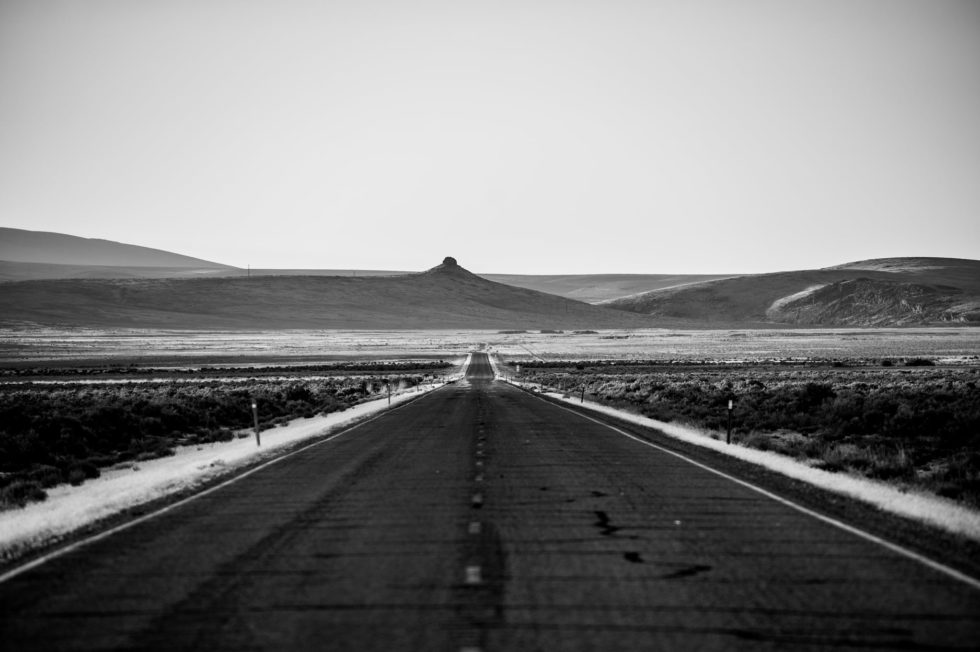
by DGR News Service | Aug 21, 2021 | Biodiversity & Habitat Destruction, Climate Change, Indigenous Autonomy, Listening to the Land, Mining & Drilling, Movement Building & Support, Obstruction & Occupation, Toxification
This article originally appeared in Protect Thacker Pass.
By Max Wilbert
The great poet and playwright James Baldwin wrote in 1953 that “People who shut their eyes to reality simply invite their own destruction.”
Perhaps never has this been truer than in this era of converging ecological crises: global warming, biodiversity collapse, desertification and soil erosion, ocean acidification, dead zones, plastic pollution, sprawling habitat destruction, and the total saturation of our environment with radioactive or toxic chemicals.
Ignorance is not bliss; it is dangerous.
That is why I am so concerned that, while searching for solutions to global warming, many people imagine that fossil fuels can be simply replaced with solar and wind energy, that gas tanks can be swapped for lithium batteries, and that this will solve the problem.
For years, I have been arguing that this is wrong, and that we need much more fundamental changes to our economy, our society, and our way of life.
For the last 6 months, I have been camped at a place in northern Nevada called Thacker Pass, which is threatened by a vast planned open-pit mine that threatens to destroy 28 square miles of biodiverse sagebrush habitat, release millions of tons of greenhouse gas emissions, bulldoze Paiute and Shoshone sacred sites, and leave behind piles of toxic waste for generations to come.
Electric cars and fossil fuel cars don’t differ as much as lithium mining companies would like us to believe. In fact, a direct link connects the water protectors fighting the new Line 3 oil pipeline in the Ojibwe territory in Minnesota and the land defenders working to protect Peehee Mu’huh, the original name for Thacker Pass in the Paiute language.
The new Line 3 pipeline would carry almost a million barrels a day of crude oil from the Alberta Tar Sands, the largest and most destructive industrial project on the planet, to refineries in the United States. On the way, it would threaten more than 200 waterbodies and carve a path through what CNN called “some of the most pristine woods and wetlands in North America.” The project would be directly responsible for millions of tons of greenhouse gas emissions.
For the last 7 years, indigenous water protectors and allies have rallied, petitioned, established resistance camps, held events, protested, and engaged in direct action to stop the Line 3 pipeline from being built. More than 350 people have been arrested over the past few months, but pipeline construction continues to progress for now.
Ironically, the proposed Thacker Pass lithium mine would require importing nearly 700,000 tons of sulfur per year — roughly equivalent to the mass of two Empire State Buildings — for processing the lithium. This sulfur would likely come (at least in part) from the Alberta tar sands, perhaps even from oil that would flow through Line 3.
Almost all sulfur, which is used in a wide range of chemical processes and fertilizers, comes from oil and gas refineries, where it’s a byproduct of producing low-sulfur fuels to meet air-quality regulations around acid rain.
According to the U.S. Geological Survey, tar sands contain 11 times as much sulfur as conventional heavy crude oil, and literal “mountains” of sulfur are piling up in Alberta and at other refineries which process tar sands fuel. Sulfur sales revenue is important to the economics of tar sands oil extraction. One report released in the early years of tar sands extraction found that “developing a plan for storing, selling or disposing of the sulfur [extracted during processing] will help to ensure the profitability of oil sands operations.”
This means that Thacker Pass lithium destined for use in “green” electric cars and solar energy storage batteries would almost certainly be directly linked to the Line 3 pipeline and the harms caused by the Tar Sands, including the destruction of boreal forest, the poisoning of the Athabasca River and other waters, and an epidemic of cancers, rare diseases, and missing and murdered indigenous women facing Alberta First Nations. And, of course, the tar sands significantly exacerbate global warming. Canadian greenhouse gas emissions have skyrocketed over recent decades as tar sands oil production has increased.
Mining is exceptionally destructive. There is no getting around it. According to the EPA, hard-rock mining is the single largest source of water pollution in the United States. The same statistic probably applies globally, but no one really knows how many rivers have been poisoned, how many mountains blown up, how many meadows and forests bulldozed for the sake of mining.
The water protectors at Line 3 fight to protect Ojibwe territory, wild rice beds, and critical wildlife habitat from a tar sands oil pipeline, oil spills, and the greenhouse gas emissions that would harm the entire world. Here at Thacker Pass, we fight the same fight. The indigenous people here, too, face the destruction of their first foods; the poisoning of their water; the desecration of their sacred sites; and the probability of a toxic legacy for future generations. I fight alongside them for this place.
Our fights are not separate. Our planet will not cool, our waters will not begin to flow clean again, our forests will not regrow, and our children will not have security unless we organize, stop the destruction, and build a new way of life. The Line 3 pipeline, and all the other pipelines, must be stopped. And so must the lithium mines.
The wind howls at Thacker Pass. Rain beats against the walls of my tent. A steady drip falls onto the foot of my sleeping bag. It’s June, but we are a mile above sea level. Summer is slow in coming here, and so the storm rages outside, and I cannot sleep. Nightmare visions of open-pit mines, climate breakdown, and ecological collapse haunt me.
James Baldwin gave good advice. In this time, we must not shut our eyes to the reality that industrial production, including the production of oil and the production of electric cars, results in industrial devastation. And with our eyes wide open, we must take action to protect our only home, and the future generations who rely on us.
Also available at The Sierra Nevada Ally, Dispatches from Thacker Pass series.


by DGR News Service | Jul 28, 2021 | Lobbying, Protests & Symbolic Acts
Editor’s note: The plan to protect the world’s wildlife (as well as the Paris Agreement) falls short because 1) Civilization is not and can never be sustainable. This is especially true for industrial civilization (Premise one), 2) The culture as a whole and most of its members are insane. The culture is driven by a death urge, an urge to destroy life (Premise ten), and, if you dig to the heart of it—if there were any heart left—you would find that social decisions are determined primarily on the basis of how well these decisions serve the ends of controlling or destroying wild nature (Premise 20). The only way to protect the world’s wildlife and the climate is to bring down the global economy.
This article originally appeared in The Conversation.
By Michelle Lim
It’s no secret the world’s wildlife is in dire straits. New data shows a heatwave in the Pacific Northwest killed more than 1 billion sea creatures in June, while Australia’s devastating bushfires of 2019-2020 killed or displaced 3 billion animals. Indeed, 1 million species face extinction worldwide.
These numbers are overwhelming, but a serious global commitment can help reverse current tragic rates of biodiversity loss.
This week the UN’s Convention on Biological Diversity released a draft of its newest ten-year global plan. Often considered to be the Paris Agreement of biodiversity, the new plan aims to galvanise planetary scale action to achieve a world “living in harmony with nature” by 2050.
But if the plan goes ahead in its current form, it will fall short in safeguarding the wonder of our natural world. This is primarily because it doesn’t legally bind nations to it, risking the same mistakes made by the last ten-year plan, which didn’t stop biodiversity decline.
A lack of binding obligations
The Convention on Biological Diversity is a significant global agreement and almost all countries are parties to it. This includes Australia, which holds the unwanted record for the greatest number of mammal extinctions since European colonisation.
However, the convention is plagued by the lack of binding obligations. Self-reporting to the convention secretariat is the only thing the convention makes countries do under international law.
All other, otherwise sensible, provisions of the convention are limited by a series of get-out-of-jail clauses. Countries are only required to implement provisions “subject to national legislation” or “as far as possible and as appropriate”.
The convention has used non-binding targets since 2000 in its attempt to address global biodiversity loss. But this has not worked.
The ten-year term of the previous targets, the Aichi Targets, came to an end in 2020, and included halving habitat loss and preventing extinction. But these, alongside most other Aichi targets, were not met.
In the new draft targets, extinction is no longer specifically named — perhaps relegated to the too hard basket. Pollution appears again in the new targets, and now includes a specific mention of eliminating plastic pollution.
Is this really a Paris-style agreement?
I wish. Calling the plan a Paris-style agreement suggests it has legal weight, when it doesn’t.
The fundamental difference between the biodiversity plan and the Paris Agreement is that binding commitments are a key component of the Paris Agreement. This is because the Paris Agreement is the successor of the legally binding Kyoto Protocol.
The final Paris Agreement legally compels countries to state how much they will reduce their emissions by. Nations are then expected to commit to increasingly ambitious reductions every five years.
If they don’t fulfill these commitments, countries could be in breach of international law. This risks damage to countries’ reputation and international standing.
The door remains open for some form of binding commitment to emerge from the biodiversity convention. But negotiations to date have included almost no mention of this being a potential outcome.
So what else needs to change?
Alongside binding agreements, there are many other aspects of the convention’s plan that must change. Here are three:
First, we need truly transformative measures to tackle the underlying economic and social causes of biodiversity loss.
The plan’s first eight targets are directed at minimising the threats to biodiversity, such as the harvesting and trade of wild species, area-based conservation, climate change and pollution.
While this is important, the plan also needs to call out and tackle dominant worldviews which equate continuous economic growth with human well-being. The first eight targets cannot realistically be met unless we address the economic causes driving these threats: materialism, unsustainable production and over-consumption.
Second, the plan needs to put Indigenous peoples’ knowledge, science, governance, rights and voices front and centre.
An abundance of evidence shows lands managed by Indigenous and local communities have significantly better biodiversity outcomes. But biodiversity on Indigenous lands is decreasing and with it the knowledge for continued sustainable management of these ecosystems.
Indigenous peoples and local communities have “observer status” within the convention’s discussions, but references to Indigenous “knowledges” and “participation” in the draft plan don’t go much further than in the Aichi Targets.
Third, there must be cross-scale collaborations as global economic, social and environmental systems are connected like never before.
The unprecedented movement of people and goods and the exchange of money, information and resources means actions in one part of the globe can have significant biodiversity impacts in faraway lands. The draft framework does not sufficiently appreciate this.
For example, global demand for palm oil contributes to deforestation of orangutan habitat in Borneo. At the same time, consumer awareness and social media campaigns in countries far from palm plantations enable distant people to help make a positive difference.
The road to Kunming
The next round of preliminary negotiations of the draft framework will take place virtually from August 23 to September 3 2021. And it’s likely final in-person negotiations in Kunming, China will be postponed until 2022.
It’s not all bad news, there is still much to commend in the convention’s current draft plan.
For example, the plan facilitates connections with other global processes, such as the UN’s Sustainable Development Goals. It recognises the contributions of biodiversity to, for instance, nutrition and food security, echoing Sustainable Development Goal 2 of “zero hunger”.
The plan also embraces more inclusive language, such as a shift from saying “ecosystem services” to “Nature’s Contribution to People” when discussing nature’s multiple values.
But if non-binding targets didn’t work in the past, then why does the convention think this time will be any different?
A further set of unmet biodiversity goals and targets in 2030 is an unacceptable scenario. At the same time, there’s no point aiming at targets that merely maintain the status quo.
We can change the current path of mass extinction. This requires urgent, concerted and transformative action towards a thriving planet for people and nature.








